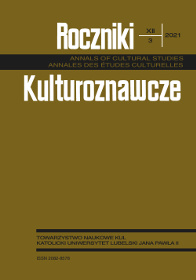Visual Dictionaries of Emotions During the COVID-19 Pandemic in Artistic Communication
Abstract
This study aimed to investigate which emotions were most often communicated through art created during a pandemic and new symbols of emotions, themes used in the creation process. Two research techniques were used in the study: content analysis and Panofsky’ Method. The research material consists of 100 illustrations from the Internet obtained after entering the keywords article and coronavirus in Google. The most common emotion was fear, next was anger, third was sadness and the least was joy. Street artists appealed to a wide variety of themes: religious, mythological, popular culture. The analysis of the research material showed that new symbols representing the SarsCov-2 pandemic appeared in the social space and culture: the coronavirus molecule (an emotionally universal symbol) and a white or blue surgical mask and latex glove symbolizing fear.
References
Action Comics. Dostęp 06.11.2020. https://dc.fandom.com/wiki/Action_Comics_Vol_1_1.
Bellantoni, Patti. Jeśli to fiolet, to ktoś umrze: teoria koloru w filmie. Tłum. Monika Dańczyszyn. Warszawa: Wydawnictwo Wojciech Marzec, 2010.
Berelson, Bernard. Content analysis in communication research. New York: Free Press, 1952.
Bociek, Beata. „Naturalne i nadprzyrodzone znaczenie symboliki światła w malarstwie okresu baroku”. Studia Elbląskie, t. 12 (2011): 409–424.
Colton, David. „The crime that created Superman. Did fatal robbery spawn Man of Steel?” USA Today z 26.08.2008. Dostęp 26.08.2008, https://usatoday30.usatoday.com/life/books/news/2008-08-25-superman-creators_N.htm.
Czyżewski, Stefan, i Piotr Sitarski. „Słownik pojęć filmowych”. Edukacja filmowa. Dostęp 14.04.2020. http://edukacjafilmowa.pl/abc-filmu/.
D’Alleva, Anne. Methods & Theories of Art History. London: Laurence King Publishers, 2012.
Eco, Umberto. Superman w literaturze masowej. Powieść popularna: między retoryką a ideologią. Tłum. Joanna Ugniewska. Warszawa: Państwowy Instytut Wydawniczy, 1996.
Ekman, Paul. „Wszystkie emocje są podstawowe”. W: Natura emocji. Podstawowe zagadniena. Red. Paul Ekman, Richard J. Davidson. Tłum. Bogdan Wojciszke. Gdańsk: GWP, 1998.
Eurostat. Statistics Explained. Dostęp 24.07.2020. https://ec.europa.eu/eurostat/statistics explained/.
Fingeroth, Danny. Superman on the Couch: What Superheroes Really Tell Us about Ourselves and Our Society. New York: Continuum/London: Bloomsbury Academic, 2004.
Gage, John. Kolor i kultura. Teoria i znaczenie koloru od antyku do abstrakcji. Tłum. Joanna Holzman. Kraków: Universitas 2008.
Geertz, Clifford. Interpretacja kultur. Wybrane eseje. Tłum. Maria Piechaczek. Kraków: Wydawnictwo Uniwersytetu Jagiellońskiego 2005.
Google. Arts and Culture. Dostęp 06.11.2020. https://artsandculture.google.com/.
Gottschalk, H.B.: „The ‘Decoloribus’ and Its Author”. Hermes, t. 92 (1964): 59–85.
Heller, Eva, i Joaquín Chamorro Mielke. Psicología del color: cómo actúan los colores sobre los sentimientos y la razón. Barcelona: Gustavo Gili, 2017.
Historia portretu. Przez sztukę do wieczności. Red. Stefano Zuffi. Autorzy: Matilde Battistini, Lucia Impelluso, Stefano Zuffi. Tłum. Hanna Cieśla. Warszawa: Arkady, 2001.
Holsti, Ole R. Content Analysis for Social Science and Humanities. Reading, MA: Addison Wesley, 1969.
Izard, Carroll E. The face of emotion. Century psychology series. New York: Appleton-Century-Crofts, 1971.
Jasielska, Aleksandra. „Reprezentacja współczesnych modeli emocji w dziełach sztuki”. Teksty Drugie, z. 6 (2013 ): 205–221.
Jennings, Lee Byron. „Termin ‘groteska’”. Tłum. Maria Bożenna Fedewicz. W: Groteska. Seria: Tematy teoretyczno-literackie. Red. Michał Głowiński, 31-53. Gdańsk: słowo/ obraz terytoria, 2003.
Koisz, Jakub „EL-Kal”. „Superman a religia”. KZ. Magazyn Miłośników Komiksu, nr 56 (2009). Dostęp 24.04.2021, https://www.kzet.pl/2009_02/m_superman.htm.
Kopaliński, Władysław. Słownik symboli. Warszawa: Oficyna Wydawnicza RYTM 2012.
Kosior, Wojciech. „Anioł w Biblii hebrajskiej. Pojęcie מלאך [mal’ach] w ujęciu statystycznym i hermeneutycznym”. Studia Judaica, nr 12(23-24) (2009): 57–79.
Krippendorff, Klaus. Content Analysis: An Introduction to Its Methodology. 2nd ed. Thousand Oaks, CA: Sage, 2004.
Krotz, Friedrich. Die Mediatisierung kommunikativen Handels. Der Wandel von Alltag und sozialen Beziehungen, Kultur und Gesellschaft durch die Medien. Wiesbaden: Westdeutscher Verlag, 2007.
Mazela, Anna. „Surrealistyczne wizje lęku w fotografiach Kaveha Hosseiniego”. W: Anatomia strachu. Strach, lęk i ich oblicza we współczesnej kulturze. Red. Bogusława Bodzioch-Bryła i Lilianna Dorak-Wojakowska. Kraków: Wydawnictwo Naukowe Akademii Ignatianum w Krakowie, 2017.
Neuendorf, Kimberly A. The Content Analysis Guidebook. 2nd ed. Thousand Oaks, CA: Sage, 2017.
Nęcki, Zbigniew, Izabela Sowa i Jerzy Rosiński. „Psychologia reklamy”. W: Ze świata reklamy. Red. Andrzej S. Barczak i Andrzej Pitrus. Kraków: Wydawnictwo Uniwersytetu Jagiellońskiego, 1999.
Nietzsche, Friedrich. Tako rzecze Zaratustra. Tłum. Wacław Berent. Toruń/Warszawa/Siedlce: Towarzystwo Wydawnicze „IGNIS“ S. A., 1922.
Ocula Magazine. Dostęp 06.11.2020. https://ocula.com/magazine/art-news/interest-in-google-arts-culture-skyrockets-as/
Oster, Gerald D., i Patricia Gould Crone. Using Drawings in Assessment and Therapy: A Guide for Mental Health Professionals. New York/London: Brunner-Routledge, 2004.
Panofsky, Erwin. Studies in Iconology: Humanistic Themes in the Art of the Renaissance. New York: Harper & Row, 1972.
Polony, Leszek. Symbol i muzyka. Kraków: Akademia Muzyczna, 2011.
Reykowski, Janusz. Eksperymentalna psychologia emocji. Warszawa: Książka i Wiedza, 1974.
Rzepińska, Maria. Historia koloru w dziejach malarstwa europejskiego. Kraków: Wydawnictwo Literackie, 1983.
Rzepińska, Maria. Siedem wieków malarstwa europejskiego. Wrocław: Zakład Narodowy im. Ossolińskich, 1986.
Skowronek, Bogusław. „Ciało, emocje, rozum. Raz jeszcze o mechanizmach odbioru filmu”, Annales Universitatis Mariae Curie-Skłodowska. Sectio N, Educatio Nova, vol. 2 (2017): 163-174.
Sturken, Marita, i Lisa Cartwright. Practises of Looking: An Introduction to Visual Culture. Oxford: Oxford University Press, 2001.
Sztompka, Piotr. Socjologia. Kraków: Znak 2002.
Tan, Ed S. „Film fabularny jako maszyna emocji”, w: Kognitywna teoria filmu. Antologia przekładów, red. Jacek Ostaszewski, 248–276. Kraków: Wydawnictwo Baran i Suszczyński, 1999.
Turska, Halina. „Veraicon w średniowiecznym Toruniu”. Acta Universitatis Nicolai Copernici. Zabytkoznawstwo i Konserwatorstwo, 44 (2013): 57–73.
Wallis, Mieczysław. „Wartości estetyczne łagodne i ostre”. W: Wybór pism estetycznych. Red. Teresa Pękala, 197–213. Kraków: Universitas, 2004.
Watson, John B.: Behaviorism. New York: Norton, 1924.
Weinstein, Simcha. „Superman: From Cleveland to Krypton. The Man of Steel’s Jewish roots”. My Jewish learning. Dostęp 12.05.2021. https://www.myjewishlearning.com/article/superman-from-cleveland-to-krypton/.





